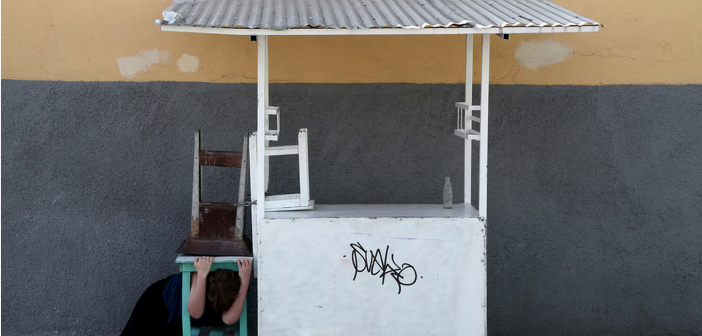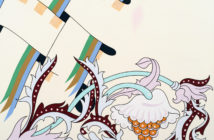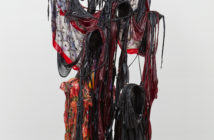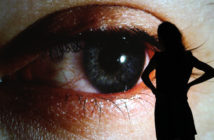Every two years the Institute of Contemporary Art Boston (ICA) selects up to four Boston-area artists to receive the James and Audrey Foster Prize. In addition to a cash award, finalists are given the opportunity to mount a show in the ICA gallery space. Since 1999, this has been a time for the ICA to showcase local talent, ultimately contributing to a larger discourse about the role that arts institutions play in supporting Boston’s creative economy.
The 2015 Foster Prize has been awarded to Ricardo De Lima, Vela Phelan, Sandrine Schaefer, and the collective kijidome; a four-way preferment that is unique in the history of the prize. This year’s line-up is also significant in its focus on performative and curatorial practices.
In the weeks leading up to the Foster Prize exhibition, we will be presenting a series of interviews with each of the Foster Prize recipients. Our first interview is with performance artist Sandrine Schaefer.
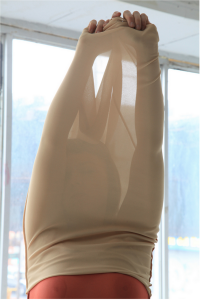
Sandrine Schaefer, "Land of Milk and Honey," (2013). Photograph by Daniel S. DeLuca. Image courtesy of the artist.
Big Red & Shiny: How were you first approached about being considered for the Foster Prize?
Sandrine Schaefer: After being nominated to be considered for the Foster Prize, The ICA invited me to submit a proposal for the creation of a new work for the exhibition.
BRS: Was there a studio visit component to the Foster Prize? What does a studio visit with a performance artist look like?
SS: Because my practice is site-specific, my studio is a space for preparation and reflection, rather than a space of making. It’s where I write, play with materials that I may consider using in a piece, edit documentation of the work, and think, but the actual artwork happens wherever I have sited the work to occur…somewhere out in the world. The ICA is making a short video about the Foster Prize winners. For this, I was interviewed in my home studio and in the Founders Gallery, so people will have a chance to see this space of reflection.
BRS: Performance art in Boston is often overlooked- do you see this changing, and if so, what role can institutions such as the ICA play in this transformation?
SS: I don’t believe that performance art is overlooked in Boston. Boston has a rich history of nurturing experiential-based media such as performance art through artist run initiatives such as Mobius and countless artists organizing opportunities for themselves and others. On an international scale, Boston is actually considered a performance art mecca! Performance art has, however, been underrepresented by major institutions in Boston.
Currently, performance art is in a liminal state in regards to the medium’s relationship to the museum. The thing we call "art" in performance art, is the creative process rather than the product of a creative process. Therefore, exhibiting performance art is very different than exhibiting any other medium. Performance art requires real time, surrendering to chance, and a lot of trust. Much of performance art’s lineage is rooted in opposition to the art institution. For example, the medium has historically defied the art market by creating works that must be experienced and are difficult to be collected/ commodified. This, coupled with the inherent chance element of working in real time, has resulted in the medium being relegated to alternative spaces or on the periphery of the museum, if included in the museum at all. Because our culture identifies the museum as the authority of the art world, it is easy for people to assume that if something isn’t included in the museum space, it isn’t of value. It is a place that designates something as "art," where people learn how to consume "art" and how to think about it. If a medium is excluded, it risks not existing to those who use the museum as an educational platform.
I have seen a shift in the 15 years I have been in Boston. There has always been a lot of artist activity in Boston and it has always been the artists who have taken on the responsibility of exhibiting experiential art. (Mobius, Test, The Present Tense, MEME, Time Body Space Objects, Non Event, Axiom, The Berwick Research Institute…I could go on and on). These artist-initiated platforms have made a significant impact on maturing the work of many artists operating internationally. Major art institutions in Boston can’t ignore this, so we are currently seeing more performance art in museums and galleries. In order for this to work, art institutions need to be willing to embrace the uncertainties of performance art. Artists in turn need to be sensitive to the concerns of art institutions while communicating what their work needs in order to be realized.
Artists in Boston have developed and contributed a sophisticated literacy around performance art that local art institutions benefit from. This presents a challenge to local arts institutions; namely how can they responsibly offer support to the local art communities in return. This is why the Foster Prize is always exciting. It is one of the only times that Boston can count on seeing itself reflected in the museum’s walls. I hope that this year’s exhibition will inspire more collaboration between art institutions and artist run organizations in the city, as I see this as something that Boston is lacking.
BRS: You mentioned that performance art requires a great deal of trust. Can you expand on that a bit?
SS: Because performance art requires real time, there is an inherent chance element to the work. Regardless of how much an artist plans and prepares for a performance art piece, anything can occur based on what is happening in the space at the time that the piece is unfolding. For example, the temperature of a space might impact the behavior of a material that an artist is using. There could be sound that travels in from the surrounding environment that suddenly becomes an unforeseen part of the piece. The greatest skill that a performance artist must continually develop and practice is responding to these real-time chance occurrences in ways that both serve the intentions of the piece and the present moment.
Generally speaking, performance art as a medium does not have standard audience etiquette attached to it in the way that some other disciplines do. For example, the audience isn’t necessarily expected to applaud or sit still when witnessing a piece. Because I am interested in dismantling traditional witnessing behaviors promoted by the entertainment industry, I make choices in my work that invite the audience to get close to my body and move around the space. This may result in witnesses engaging with the work in ways I may not expect. The inherent chance element and giving the audience agency are fundamental to performance art and require a great deal of trust for all involved. The artist needs to have conviction, trust their process, trust the audience, and trust the curator’s vision. The curator also needs to trust their own vision, the artist’s process, and the audience.
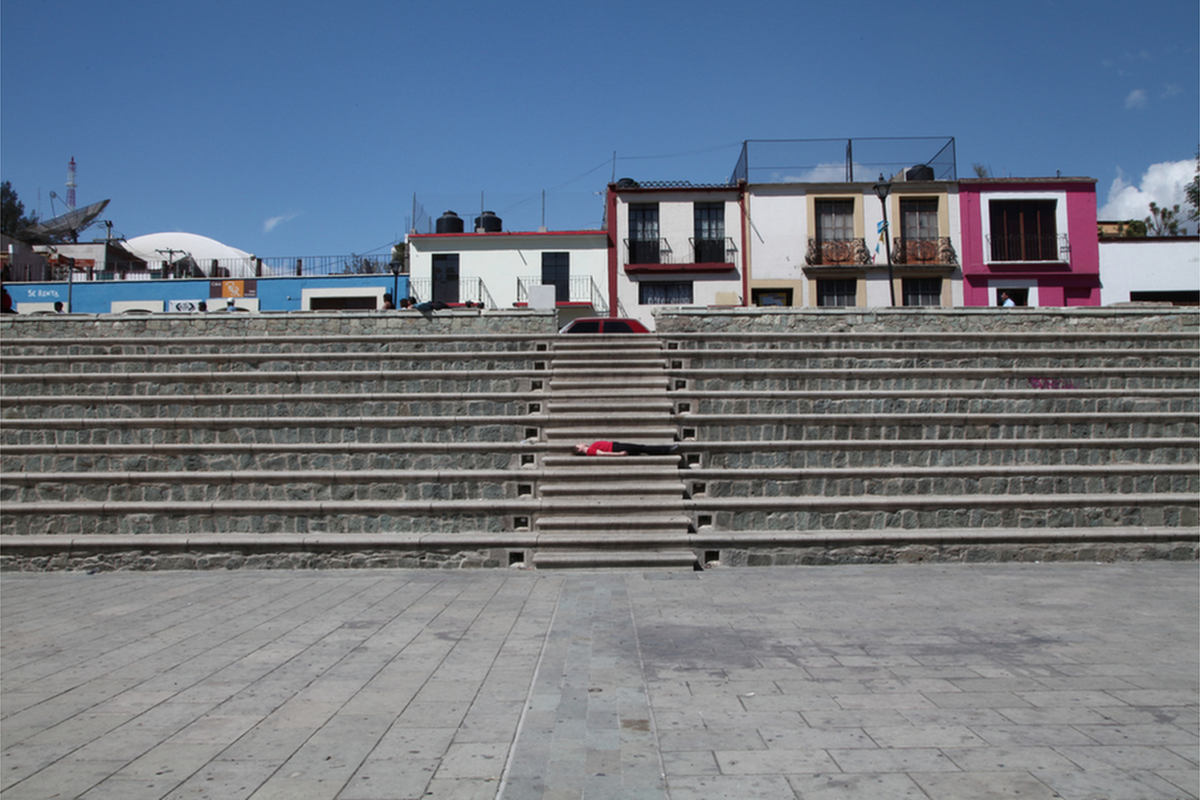
Sandrine Schaefer, "Heart Beat | Stairs," (2012). Photograph by Daniel S. DeLuca. Image courtesy of the artist.
BRS: Much of your work has been closely related to site: tying your body to the space both physically and metaphorically. Will you be taking advantage of the unique architecture of the ICA in your upcoming exhibition?
SS: Yes, my practice is always site-sensitive. For the Foster Prize exhibition, I will create a series of 5 performance art pieces that are sited in and/or viewable from the Founders Gallery (the glass hallway on the 4th floor). Nowhere else in the museum is one greeted with such an undeniable consciousness of the environment that surrounds the building. This series, titled Wandering With the Horizon—A Body in Light, will explore the site of the Founders from varied points of reference. For example, in one piece, the primary audience will shift from those who gather/pass through the Founders Gallery to those passing by the ICA in boats and those across the Harbor in East Boston. In another piece, my body will be installed outside of the gallery. The site line of my physical positioning will require people to gather unusually close to the windows and each other in order to see the performance. This turns the audience into unknowing collaborators as they activate the space in the Founders Gallery with their own bodies. In yet another piece I will be installed on the pier in East Boston. My actions will be viewable both from the Founders Gallery and through a live feed that will be available on the computers in the Media Tech for the duration of the piece.
All of the pieces will utilize the constant view of the horizon and natural light present in the space to investigate notions of liminality, the idea of the infinite horizon in relation to human scale, and the impact that the external environment has on the Founders Gallery. Minimal traces from each piece will remain and accumulate in the space, creating an experiential archive of the evolution of the work that will require visitors to confront their own physicality even when the performance art pieces are not happening. By the end of the exhibition, the space will have experienced a sensorial transformation through the accumulation of these subtle traces.
In addition to considering the architecture of the ICA, I am reflecting on the context of the museum and the previously mentioned complexities between the institution and the medium that I have aligned myself with. Wandering With the Horizon—A Body in Light will create a position that dismantles the expectation to entertain that is commonly perpetuated by the museum space by creating a space for contemplation that nurtures the audience’s natural tendencies towards active witnessing. Performance art is unique in that the focus is often placed on encountering a body engaged in action. This encounter creates an immediate and visceral connection between the audience and artist that heightens the potential for the viewer to have an empathetic response to the artist. This empathetic response can often function as an invitation into participatory viewing. These notions around witnessing are a foundation in much of my work. I am interested in asking, what happens when we intentionally design a piece that requires the audience to swarm and disseminate? How can the site be expanded through these acts of witnessing?
All 5 live pieces invite visitors to witness my creative process as it unfolds through an extended duration (between 6-7 hours). Extended duration invites a come-and-go experience that is already promoted within a museum context. However, the project actively challenges the 17-second average that visitors to museums spend engaging with a single artwork, by nurturing a space for returning. Within each piece, accumulation and progression are identified early on to inspire a curiosity to return to the Founders throughout the day. Similarly, each piece will build off of the next, encouraging visitors to return throughout the weeks of the Foster Prize exhibition. My hope is that the work will offer an opportunity to contribute to the global discourse around how performance art is pushing forward to include the art institution in its future while also offering those who encounter the work an experience that heightens their awareness of the nuances of the space and the ways that their bodies might navigate through it.

